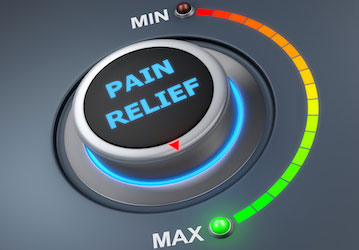Relaxation, meditation, imagery, and redirection strategies may be helpful to reduce pain. These mind-body techniques can help you consciously relax your body, slow your breathing, reduce your blood pressure, and improve your sense of well-being. These techniques can also help you shift your focus to other things besides your pain.
Mind-body methods such as relaxation, meditation, and redirection can help reduce your feelings of pain.
Pain is usually quite stressful, and stress causes muscles to tense, which makes pain worse—creating a cycle of pain. Mind-body techniques such as relaxation, meditation, guided imagery, and redirection release tension, reduce negative thoughts about pain, and may cancel out some of the negative effects of stress. They also are used to calm emotions and improve sleep—both of which can also improve your feelings of pain.
The good things about mind-body techniques are that they can be done virtually anywhere, take only a short amount of time, and can be used along with other pain treatments.
Relaxation techniques
The National Center for Complementary and Alternative Medicine (NCCAM) article about relaxation techniques describes them as “practices to help bring about the body’s ‘relaxation response,’ which is characterized by slower breathing, lower blood pressure, and a reduced heart rate.” There is some evidence that relaxation techniques may help reduce pain (as part of a larger treatment plan), specifically from headaches, low-back pain, arthritis, and pain after surgery.
Specifically, progressive muscle relaxation may be helpful for arthritis, jaw pain, and other non-muscular painful conditions. Here are some relaxation methods you can try:
- The Veterans Health Administration offers recordings and videos on mindfulness exercises such as breathing, relaxation, and meditation. VHA also has a detailed description of how to practice Progressive Muscle Relaxation and Guided Imagery.
- HPRC has an article and video on tactical breathing for the military to help improve human performance optimization.
- The War Related Illness & Injury Center (WRIISC) has a handout on two types of controlled breathing: alternate nostril breathing and ocean breath.
- DHA Mobility has several mobile apps designed to help you reduce stress, including Tactical Breather, BioZen, and Breathe2Relax.
Meditation
In general, meditation trains you to have a focused and calm mind and rhythmic breathing. It may sound easy, but it requires practice. The payoffs are improved well-being, reduced pain, and relaxation. Meditation is believed to reduce pain by reducing stress, but more research is needed to gain a better understanding of how meditation impacts chronic pain.
“Mindfulness meditation” is a type of meditation that has been well-studied as a pain-management tool, but it also has many other benefits. Mindfulness meditation helps you focus on what is happening in the present. The idea is that you can better understand your body, your thoughts, and your surroundings as a way to accept the world. Some specific forms, such as mindfulness-based stress reduction (MBSR), can improve your sense of well-being and reduce stress, depression, and pain. Shamatha and Vipassana forms of mindfulness meditation can significantly reduce the sense of pain intensity. HPRC has an article that can help you practice mindful meditation. VHA also offers the Mindfulness Coach app.
Imagery
Imagery is a method in which you visualize activities or places that stimulate your senses. Various methods include guided imagery, creative imagery, and motor imagery. You can use a practitioner or a recording to guide your imagery session. Or you can simply sit quietly and let your mind go free as you try to imagine things, using as many as all 5 senses. As another example of guided imagery, you can listen to your own recording of a happy personal memory 3 times a week for 3 weeks to help with migraines and other headaches.
Dartmouth College provides more examples of guided imagery and visualization exercises you can try.
Redirection
Redirection methods such as distraction can help you focus on something other than your pain. You can refocus on things you enjoy—such as engaging in your favorite hobby, watching a movie, playing a game, or conversing with friends—to distract you away from pain.
Virtual reality and video games are cutting-edge techniques that show promise as redirection methods to reduce pain. Burn, chronic, phantom, and post-surgical pain especially may benefit from the use of virtual reality.
Concerns
Mind-body techniques do have a few side effects. Some people become bored or sleepy during some of these techniques, but there are enough options that you should be able to find one that suits you. Mind-body practices also may increase symptoms of depression, anxiety, agitation, or mild confusion in some people. Also, motor imagery (that is, visualizing specific movements) should be used with caution, because it can make some specific types of pain worse.
Debrief
Mind-body techniques can be done virtually anywhere (a plus for on-the-move Service Members), often take only a short amount of time, and can be used along with other pain treatments. You can do them alone or with other people, and with or without the help of a professional. The military and VHA are actively looking for ways to use mind-body techniques for many health conditions, including pain management. Free and low-cost meditation classes for Warfighters and veterans are available around the country, so ask your local DoD/VHA healthcare providers for referrals. In addition, some MTFs offer alternative pain-management therapies through Tricare. For more technical information, the Defense Centers of Excellence for Psychological Health and Traumatic Brain Injury report—Mind-Body Skills for Regulating the Autonomic Nervous System—reviews the evidence on mind-body skills and discusses their military relevance.
Note: This article is an educational overview that describes the use of mind-body techniques as a strategy for pain management. It is not a comprehensive review of the current state of the research.
This article was originally created in collaboration with the Defense & Veterans Center for Integrative Pain Management.
